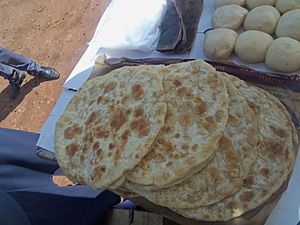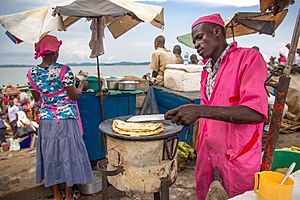Rolex (food) facts for kids
The Ugandan Rolex, often just called Rolex, is a very popular food from Uganda. It's a tasty meal made by wrapping an egg omelette and fresh vegetables inside a flatbread called a chapati. This dish is quick to make and can be enjoyed any time of day, whether for breakfast, lunch, dinner, or as a snack. The name "rolex" comes from how it's made: the chapati and omelette are "rolled eggs" together.
This clever idea started with a chapati seller in the Busoga region of Uganda. It quickly became popular near Makerere University in Wandegeya. Students loved it because it was a fast, cheap, and filling meal. Soon, the Rolex spread all over Uganda. People enjoy it for being easy to get, affordable, and delicious.
Contents
Different Kinds of Rolex
There are a few fun names for different versions of the Rolex:
- "Titanic": This is a bigger Rolex! It uses two or more chapatis to wrap the omelette and vegetables.
- "Kikomando": For this version, the chapati is cut into pieces and mixed with beans. The name "Kikomando" comes from commando soldiers who eat quickly in the field. It can also mean someone who isn't afraid to get a little messy eating street food with their hands.
Rolex and Tourism
The Rolex is a common fast food in Ugandan cities. It can be very cheap, sometimes costing as little as USh 1,000 (about US$0.28). Recently, Ugandan officials have even started promoting the Rolex as a special food for tourists to try when they visit the country.
World Record Rolex
A giant Rolex once made it into the Guinness World Records! This huge Rolex weighed 204.6 kilograms (about 451 pounds) and was 2.32 meters (about 7 feet 7 inches) long.
Making the Giant Rolex
To make this massive dish, they used a lot of ingredients:
- 1,200 eggs
- 90 kilograms (about 198 pounds) of vegetables like onions, tomatoes, cabbages, carrots, and peppers
- 72 kilograms (about 158 pounds) of flour
- 40 kilograms (about 88 pounds) of cooking oil
Ugandan YouTuber Raymond Kahuma led a team of 60 people, including chefs and bakers. They worked for 14 hours, mixing, kneading, chopping, and frying all the ingredients. They set up a temporary kitchen outdoors in Kampala. It was a big challenge, not just for cooking but also for physics! Moving the huge dough onto the frying plate without it breaking was tricky. Getting the finished Rolex onto a weighing machine was also a big task. Kahuma and his team spent months getting ready for this record-breaking attempt.
See also
 In Spanish: Rolex (comida) para niños
In Spanish: Rolex (comida) para niños



